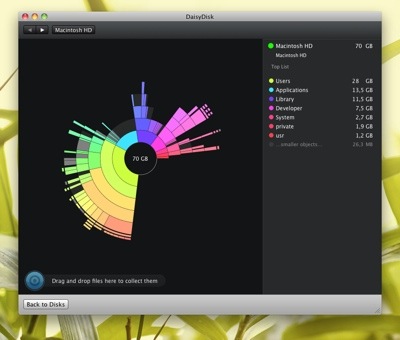

The trash-to-delete method may leave some junk files behind, resulting in incomplete uninstall. That means, if you simply trash the app and think the removal is done, you’re wrong. Additionally, some apps may create supporting files, caches, login files scattering around the system directory. General knowledge: Once installed, an app is typically stored in the /Applications directory, and the user preferences for how the app is configured are stored in ~/Library/Preferences directory.
#Daisydisk mac how to
If you have no clue how to do it right, or have difficulty in getting rid of DaisyDisk 4.6.2, the removal solutions provided in the post could be helpful. This page is about how to properly and thoroughly uninstall DaisyDisk 4.6.2 from Mac. Removing applications on Mac is pretty straightforward for experienced users yet may be unfamiliar to newbies.
#Daisydisk mac for mac
Retrieved 5 January 2019.Perfect Solutions to Uninstall DaisyDisk 4.6.2 for Mac ^ a b "Make Your HD Bigger with DaisyDisk for Mac ".^ a b "Review: DaisyDisk: Disk Visualization and Analyzer Tool for the Mac".^ "How to free up disk space in macOS High Sierra".^ "Top 5 questions about APFS and macOS High Sierra asked by Mac users".^ "An Evaluation of Space-Filling Information Visualizations for Depicting Hierarchical Structures" (PDF).^ "Make Your HD Bigger with DaisyDisk for Mac ".^ "How to identify the biggest space wasters on your Mac with DaisyDisk".

^ a b "DaisyDisk: Futuristic Data Visualization".
#Daisydisk mac software
#Daisydisk mac mac os x
One of the ways DaisyDisk integrates with the Mac features is through its support of the Quick Look function, which is included in Mac OS X v10.5 "Leopard" and later. Īs of DaisyDisk v3, a specialized version of the app exists for Mac users with Retina Displays. ĭaisyDisk provides a Trash-like collector icon in the lower left of its interface where files and folders can dragged and dropped for deletion. The interface shows a "breadcrumb trail" of the current folder right above the sunburst diagram. When clicking on a folder on the daisy, a new daisy is displayed with the chosen folder as its root. When hovering over a file or folder, the right sidebar of the interface updates with contextual information such as the file or folder name and their absolute path. In the right sidebar of the interface, DaisyDisk also provides a legend for these color codes. This daisy is color-coded to differentiate between folders, while files themselves are always displayed as gray. The interface places the root of the hard drive at the center of this daisy, and displays a hierarchical structure of that hard drive's file system that radiates from that center. Interface ĭaisyDisk displays the contents as a color-coded sunburst diagram, resembling the petals of a daisy. With v4.5 of DaisyDisk, support for APFS was added. DaisyDisk can scan multiple disks in parallel. Once the initial scan is completed, DaisyDisk keeps all displayed information up to date and reflects all changes to disk in real-time. Features ĭaisyDisk needs to scan the disk to create a map of its files and folders. They decided to use a sunburst diagram as it is perceived better than other ways of visualizing data (such as treemaps). They built the codebase from scratch to try to achieve higher speeds than similar programs.

DaisyDisk was started in late 2008 by interaction designer Taras Brizitsky and programmer Oleg Krupnov.


 0 kommentar(er)
0 kommentar(er)
